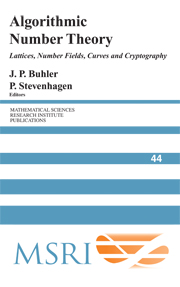Book contents
- Frontmatter
- Contents
- Preface
- Solving the Pell equation
- Basic algorithms in number theory
- Smooth numbers and the quadratic sieve
- The number field sieve
- Four primality testing algorithms
- Lattices
- Elliptic curves
- The arithmetic of number rings
- Smooth numbers: computational number theory and beyond
- Fast multiplication and its applications
- Elementary thoughts on discrete logarithms
- The impact of the number field sieve on the discrete logarithm problem in finite fields
- Reducing lattice bases to find small-height values of univariate polynomials
- Computing Arakelov class groups
- Computational class field theory
- Protecting communications against forgery
- Algorithmic theory of zeta functions over finite fields
- Counting points onvarieties over finite fields of small characteristic
- Congruent number problems and their variants
- An introduction to computing modular forms using modular symbols
Four primality testing algorithms
Published online by Cambridge University Press: 30 May 2025
- Frontmatter
- Contents
- Preface
- Solving the Pell equation
- Basic algorithms in number theory
- Smooth numbers and the quadratic sieve
- The number field sieve
- Four primality testing algorithms
- Lattices
- Elliptic curves
- The arithmetic of number rings
- Smooth numbers: computational number theory and beyond
- Fast multiplication and its applications
- Elementary thoughts on discrete logarithms
- The impact of the number field sieve on the discrete logarithm problem in finite fields
- Reducing lattice bases to find small-height values of univariate polynomials
- Computing Arakelov class groups
- Computational class field theory
- Protecting communications against forgery
- Algorithmic theory of zeta functions over finite fields
- Counting points onvarieties over finite fields of small characteristic
- Congruent number problems and their variants
- An introduction to computing modular forms using modular symbols
Summary
In this expository paper we describe four primality tests. The first test is very efficient, but is only capable of proving that a given number is either composite or ‘very probably’ prime. The second test is a deterministic polynomial time algorithm to prove that a given numer is either prime or composite. The third and fourth primality tests are at present most widely used in practice. Both tests are capable of proving that a given number is prime or composite, but neither algorithm is deterministic. The third algorithm exploits the arithmetic of cyclotomic fields. Its running time is almost, but not quite polynomial time. The fourth algorithm exploits elliptic curves. Its running time is difficult to estimate, but it behaves well in practice.
In Section 2 we discuss the Miller–Rabin test. This is one of the most efficient probabilistic primality tests. Strictly speaking, the Miller–Rabin test is not a primality test but rather a ‘compositeness test’, since it does not prove the primality of a number. Instead, if n is not prime, the algorithm proves this in all likelihood very quickly. On the other hand, if n happens to be prime, the algorithm merely provides strong evidence for its primality. Under the assumption of the Generalized Riemann Hypothesis one can turn the Miller–Rabin algorithm into a deterministic polynomial time primality test. This idea, due to G. Miller, is also explained.
In Section 3 we describe the deterministic polynomial time primality test that was proposed by M. Agrawal, N. Kayal and N. Saxena in 2002 [Agrawal et al. 2004]. At the moment of this writing, this new test, or rather a more efficient probabilistic version of it, had not yet been widely implemented. In practice, therefore, for proving the primality of a given integer, one still relies on older tests that are either not provably polynomial time or not deterministic. In the remaining two sections we present the two most widely used such tests.
Information
- Type
- Chapter
- Information
- Algorithmic Number TheoryLattices, Number Fields, Curves and Cryptography, pp. 101 - 126Publisher: Cambridge University PressPrint publication year: 2008
Accessibility standard: Unknown
Why this information is here
This section outlines the accessibility features of this content - including support for screen readers, full keyboard navigation and high-contrast display options. This may not be relevant for you.Accessibility Information
- 1
- Cited by
